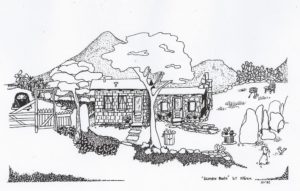The Wilder Family of Wilder Oaks & The MacPhearson/Hawkins Family of Obanshire
Albert & Nettie Wilder first settled Wilder Oaks in 1925 when Albert was given two small building lots in the new mountain development of Suncrest, Inc. by Ray Coats, circulation manager of E.B. Scripps San Diego Sun newspaper. In return, Wilder was to lay out a golf course for the planned recreational subdivision which included a swimming pool, baseball diamond, clubhouse and community park. Albert Wilder and his wife Nettie decided that the innovative, craggy retreat of coyote and chaparral appealed to them so much that they would acquire a larger parcel on what is now 211 South Lane.
As to what happened to the golf course – it probably was short lived, as grass and putting-greens demand oh-so-much water which has always been a precious commodity. Old timers couldn’t pinpoint just where it might have been originally.
South Lane Park provided the northern boundary of Wilder Oaks. Wilder Oaks was named for the many native live oaks which the Wilders were pleased to find on their new property. Near the well is a large rock outcropping. Native Americans obviously used to gather acorns here, for many pits of Indian metate and a few pieces of broken pestles were found there.

There were three cottages on the property built in the mid-1920s by Albert and Nettie. Unfortunately, all buildings were destroyed in the 1970 and 2003 wildfires (pictured to the left was the guest cottage that burned in 2003). It was intended to be a weekend retreat. However, when the depression hit and the stock market took its disastrous nose dive, the Wilders and members of their extended family sold their homes in San Diego. They moved to Wilder Oaks in 1931, making it their primary residence. Al had been manager of the Commonwealth Bank in San Diego, but the Commonwealth went the way of all banks in that crisis. Al later went to work for Sears.
The family lived and worked together to survive the Great Depression which lasted until the beginning of World War II in 1941.Their daughter, Helen Wilder Longman and her children, Sara and Raymond, lived in the “stone house.” Various family members lived in the other houses. Albert and his uncle Arthur began a nursery business raising geranium cuttings to ship to Arthur’s florist contact in the East. He constructed a lath house next to the fence on South Lane. He also built a fish pond next to the path. With joint effort, they developed a flower nursery and shipped geranium cuttings and imported Dutch iris bulbs to mail order customers all over the United States. A hand-dug, brick-lined well and water-storage reservoir provided irrigation for the crops. On weekends, they cooked and served chicken dinners to the public in the main, big house under the green canopy of oak, eucalyptus, and pine trees. Nettie took in boarders who she called “paying guests” and served Sunday dinners at the table that could seat fourteen. Among her regular dinner guests were a number of doctors and the Episcopal bishop of San Diego. For many years, the Wilder clan was an active and important part of the Suncrest community.
In the early 1940s Albert and Nettie decided that Wilder Oaks was getting to be too much for them; with a war on, they couldn’t get any helpers. In 1942, they sold their home to Dr. James and Esther Macpherson McColl.
James and Esther Cathryn Macpherson McColl/Kathryn Hawkins Family
 The McColls bought a weekend cabin on Crest Drive 1934. In 1942 they sold their existing cabin which they had enjoyed during weekends and summers and purchased the Wilder Oaks property. Wilder Oaks name was later changed to Obanshire, named for the area in Scotland from whence the McColl clan came. The McColls’ daughter, Kathryn Hawkins raised her three daughters at Obanshire. Kathryn was a strong supporter of community issues, including the Crest Planning Commission, the Crest Library, and the Crest Historical Society. Kathryn passed away in 2001. The Hawkins family lost all the remaining buildings to the 2003 Cedar Fire and the property was sold a couple years later.
The McColls bought a weekend cabin on Crest Drive 1934. In 1942 they sold their existing cabin which they had enjoyed during weekends and summers and purchased the Wilder Oaks property. Wilder Oaks name was later changed to Obanshire, named for the area in Scotland from whence the McColl clan came. The McColls’ daughter, Kathryn Hawkins raised her three daughters at Obanshire. Kathryn was a strong supporter of community issues, including the Crest Planning Commission, the Crest Library, and the Crest Historical Society. Kathryn passed away in 2001. The Hawkins family lost all the remaining buildings to the 2003 Cedar Fire and the property was sold a couple years later.
Kathryn McColl Hawkins wrote, “Over the years, extended families have formed lasting bonds with Crest; they shared fond memories with others of scrambling over big rocks, listening to the howl of coyotes, the lilt of frogs and song birds, scratching poison oak, coming to like the smell of skunks, and to love the fogs enveloping the base of the distant mountains.”